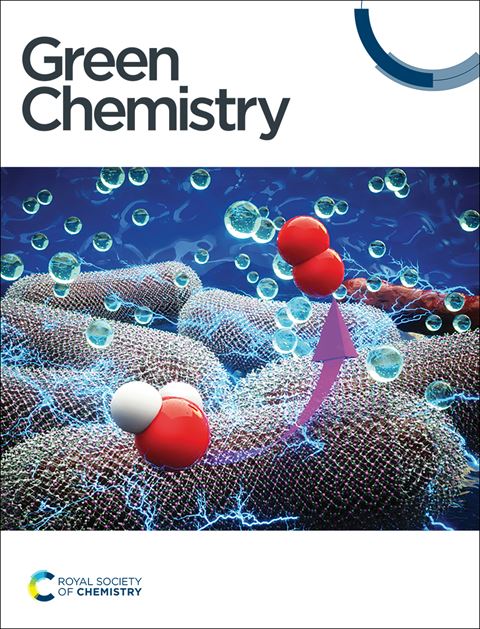Efficient CO2 electroreduction to n-propanol on a matching cobalt phthalocyanine/copper tandem catalyst†
IF 9.3
1区 化学
Q1 CHEMISTRY, MULTIDISCIPLINARY
引用次数: 0
Abstract
Electroreduction of CO2 into n-propanol is a promising strategy to mitigate energy and environmental problems. However, achieving high selectivity of n-propanol at high current density remains a challenge. In this work, we report an efficient tandem catalyst by combining cobalt phthalocyanine coordinating with tetrahydrofuran (CoPc-THF) and CuO derived Cu (OD-Cu). The selectivity of n-propanol was enhanced over CoPc-THF/OD-Cu tandem catalysts, and the faradaic efficiency (FE) of n-propanol reached up to 16.8% with a current density of 170 mA cm−2. It was demonstrated that CO2 could be converted into CO over CoPc-THF with nearly 100% FE in a wide potential range, which enhances the CO coverage on OD-Cu at a high potential, resulting in high selectivity of n-propanol.
在匹配的钴酞菁/铜串联催化剂上高效的CO2电还原成正丙醇
电还原二氧化碳成正丙醇是一种很有前途的策略,以减轻能源和环境问题。然而,在高电流密度下实现正丙醇的高选择性仍然是一个挑战。在这项工作中,我们报道了一种高效的串联催化剂,将酞菁钴与四氢呋喃(CoPc-THF)和CuO衍生铜(OD-Cu)结合。在CoPc-THF/OD-Cu串联催化剂上,正丙醇的选择性增强,当电流密度为170 mA cm−2时,正丙醇的法拉第效率(FE)达到16.8%。结果表明,在较宽的电位范围内,近100% FE的CoPc-THF可以将CO2转化为CO,从而提高了cod - cu在高电位下的CO覆盖率,从而提高了正丙醇的选择性。
本文章由计算机程序翻译,如有差异,请以英文原文为准。
求助全文
约1分钟内获得全文
求助全文
来源期刊

Green Chemistry
化学-化学综合
CiteScore
16.10
自引率
7.10%
发文量
677
审稿时长
1.4 months
期刊介绍:
Green Chemistry is a journal that provides a unique forum for the publication of innovative research on the development of alternative green and sustainable technologies. The scope of Green Chemistry is based on the definition proposed by Anastas and Warner (Green Chemistry: Theory and Practice, P T Anastas and J C Warner, Oxford University Press, Oxford, 1998), which defines green chemistry as the utilisation of a set of principles that reduces or eliminates the use or generation of hazardous substances in the design, manufacture and application of chemical products. Green Chemistry aims to reduce the environmental impact of the chemical enterprise by developing a technology base that is inherently non-toxic to living things and the environment. The journal welcomes submissions on all aspects of research relating to this endeavor and publishes original and significant cutting-edge research that is likely to be of wide general appeal. For a work to be published, it must present a significant advance in green chemistry, including a comparison with existing methods and a demonstration of advantages over those methods.
 求助内容:
求助内容: 应助结果提醒方式:
应助结果提醒方式:


